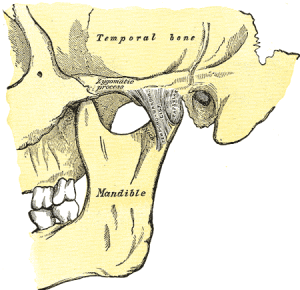TMJ & Chiropractic

The bones and structure of the left temporomandibular joint.
The TMJ is a hinge joint that connects the mandible (jaw) to the temporal bone of the skull.
An articular disc separates the mandible and the temporal bone. It moves in three different directions.
It acts as a hinge, allowing opening and closing of the mouth, and it also moves forward and backward, as in jutting the jaw, known as protrusion and retrusion respectively, and from side to side.
It is surrounded by 68 pairs of muscles immediately in front of the ear on each side of the head.
If you put your finger in your ear and then push forward while you open and close your mouth you should be able to feel it. This joint is one of the most frequently used in the body.
The jaw allows you to chew, yawn, speak, and swallow and are is in constant use.
It is because of this constant use that an estimated 85-90% of people will experience some problem with their TMJ during their life.
It is noted that women suffer from this disorder four times more than men do.
What is TMJ disorder?
TMJ disorders can be caused in a variety of ways.
A car accident, a punch to the jaw, arthritis or stress-related clenching and teeth grinding are all possible culprits.
TMJ disorder (TMJ Syndrome) is a blanket term for acute or chronic inflammation of the temporomandibular joint.
Researchers agree that TMD falls into three categories:
- Myofascial pain—discomfort or pain in the muscles of the jaw, neck, and shoulders;
- A dislocated jaw or displaced disc;
- Degenerative joint disease—rheumatoid arthritis or osteoarthritis in the jaw joint.
TMJ can cause the following symptoms
- Discomfort and pain in the jaw
- Radiating pain in the face, neck, or shoulders;
- Limited movement or locking of the jaw;
- Painful clicking, grinding or grating when opening or closing the mouth;
- A significant change in the way the upper and lower teeth fit together;
- Headaches, earaches, dizziness, hearing problems and difficulty swallowing;
- Ear pain, earaches or ringing in the ears (tinnitus);
- Chipped or cracked teeth.
The articular disc is fitted so that the condyle head of the mandible can slide smoothly up and down.
The clicking noise will occur when the condyle head is not in the proper fitted position and passes over the ridge of the disc.
As the bone passes over the ridge it will cause a click or pop that can lock the jaw in either the open or closed position and usually requires a manual adjustment to dislodge it back into normal working order.
The grinding or crunching noises occur when there is bone on bone contact within the joint.
If the articular disk is completely out of place or has worn through, the jawbone will move on its hinge, but in direct contact with the skull.
This could be caused by arthritis wearing away the cartilage of the bones. If you experience noises when you move your jaw consult a chiropractor to help determine the severity.
Chiropractic Treatment for TMJ
Chiropractic care can be effective in reducing the pain that is associated with TMJ disorders.
With this disorder, it is essential release the tensed muscles of the jaw. Your chiropractor will evaluate the TMJ, surrounding muscles, and the biomechanics of mouth opening and closing.
Your chiropractor will also evaluate the upper neck because studies have shown it is more common to have both TMJ and upper neck problems combined than to have just TMJ problems.
Your chiropractor will use muscle stretching and precise trigger point therapy to relax any muscles that are too tight, and will perform gentle mobilization to the TMJ or neck to restore proper motion to the joints.
You will also be given exercises to retrain the muscles and promote proper opening and closing of the TMJ.
While you’re recovering you may want to avoid eating crunchy food.
While some people feel better with adjustments alone, others find that chiropractic work combines well with other treatments, such as bite plates prescribed by a dentist.
What will happen when I visit the Chiropractor?
You will first receive a full workup including an evaluation of your spine and muscles surrounding the neck.
You will have your jaw and bite evaluated.
Once TMJ syndrome is determined, you will have all your spinal mis-alignments corrected. You will have your neck muscles massaged, stretched and evaluated for weakness.
If muscular weakness is evident, you will receive exercises to correct it.
Your posture will also be evaluated and corrected if necessary.
Then we go into the jaw. Relaxing the tight jaw muscles, the pterygoids, requires going into the mouth with the doctor’s gloved finger.
The muscles are then massaged until they relax. The good news is that it doesn’t take much to relax them on each session, approximately one minute.
The first couple of sessions can be a little uncomfortable, but over time the muscles become looser, freeing up the jaw. Your chiropractor will also assess your cranium in general and perform any cranial therapy where necessary.
Take this quick quiz to see if you have a TMJ problem?
- Does it hurt when you chew, open wide to yawn or use your jaws?
- Do you have pain or soreness in front of the ear, in the jaw muscle, cheek, the teeth or the temples?
- Do you have pain or soreness in your teeth?
- Do your jaws make noises loud enough to bother you or others?
- Do you find it difficult to open your mouth wide?
- Does your jaw ever get stuck/locked as you open it?
If you answered “yes” to some of these questions, you may have a temporomandibular joint disorder.
Call Discover Chiropractor today for a complete health assessment!
